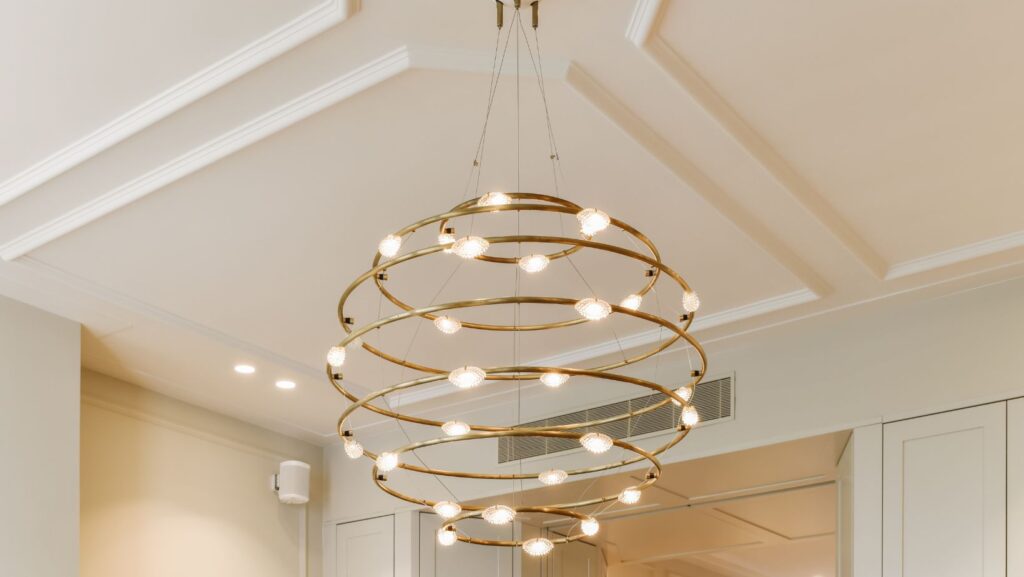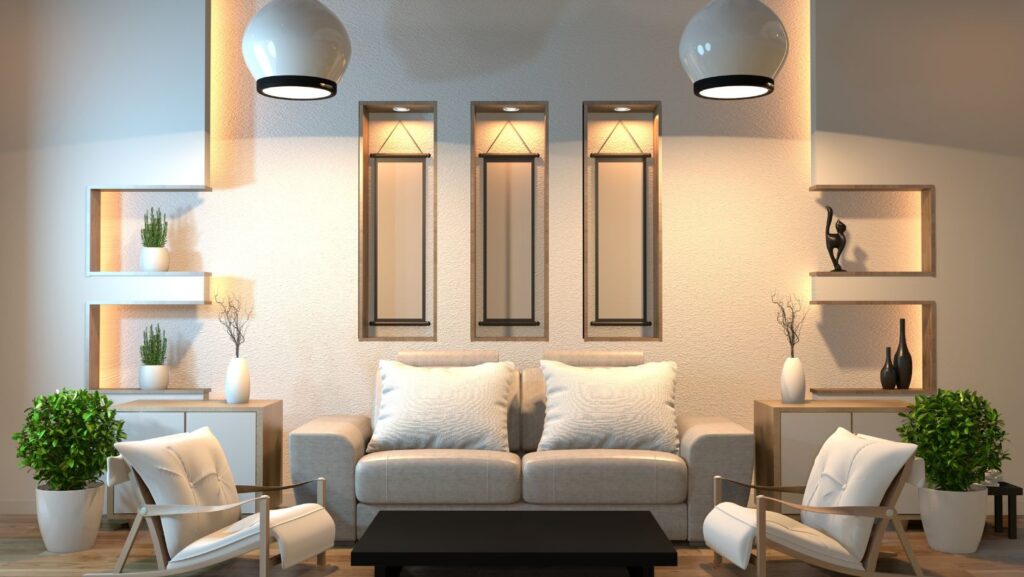Living in a small space can be challenging, especially when creating a comfortable and inviting atmosphere. One often overlooked aspect of home lighting design is the potential of ceiling lights to transform a room and make it feel larger than it is. In this article, we’ll explore various ceiling light design techniques and fixtures that can help you maximize your small space and create a beautiful, functional home.
The Importance of Ceiling Lighting in Small Spaces
Ceiling lights are crucial in any room but are especially important in small spaces. Unlike table lamps or floor lamps, ceiling lights don’t take up valuable floor space, which is often at a premium in compact rooms.
Ceiling lights also provide general illumination for the entire room, creating a bright and open feel. This is particularly important in small spaces, where insufficient lighting can make the room cramped and claustrophobic.
Moreover, ceiling lights can be the room’s focal point and design element. Choosing a stylish and eye-catching fixture allows you to draw the eye upward and create a sense of height, making the space feel larger and more expansive.
Types of Ceiling Lights for Small Spaces
When selecting ceiling lights for a small space, choosing fixtures that provide ample illumination without overwhelming the room is essential. Here are some common types of ceiling lights that work well in compact areas:
Flush Mount Lights
Flush mount lights are fixtures that sit directly against the ceiling, with little or no gap between the fixture and the ceiling surface. They’re an excellent choice for small spaces with low ceilings, as they don’t hang down and take up visual space.
Flush-mount lights come in various styles, from simple and understated to bold and decorative. They can also be used in multiples to provide even illumination throughout the room.
Semi-Flush Mount Lights
Semi-flush mount lights are similar to flush mount lights but hang slightly from the ceiling. They provide more visual interest than flush mounts and can be a good choice for rooms with slightly higher ceilings.
Semi-flush mounts often feature decorative shades or diffusers that soften the light and add a touch of style to the room. They can also be used in pairs or groups to create a cohesive look.
Pendant Lights
Pendant lights hang down from the ceiling on a cord or chain. While they may seem counterintuitive for small spaces, pendants can be a great choice when used strategically.
For example, hanging pendant light over a dining table or kitchen island can provide focused task lighting and serve as a decorative element. Pendants with transparent or translucent shades can also help diffuse light.
When using pendants in small spaces, be sure to choose fixtures that are proportionate to the size of the room and hang them at an appropriate height to avoid visual clutter.
Recessed Lights
Recessed or can lights are fixtures installed into the ceiling, creating a sleek, streamlined look. They’re popular for small spaces because they provide excellent general illumination without taking up any visual space.
Recessed lights can be used in various configurations to highlight specific areas or create a warm, inviting ambiance. They can also be fitted with dimmer switches for adjustable light levels.
Track Lights
Track lights are fixtures mounted on a track system, allowing for flexible positioning and directional lighting. They’re a great choice for small spaces because they can highlight specific areas or artwork without taking up valuable floor or table space.
Track lights come in various styles and finishes, from sleek and modern to rustic and industrial. They can also be fitted with various light bulbs, including energy-efficient LEDs.
Ceiling Light Design Techniques for Small Spaces
In addition to choosing the right fixtures, several ceiling light design techniques can help make a small space feel larger and more inviting. Here are a few tips to keep in mind:
Use Lighter Colors and Reflective Finishes
Dark colors absorb light, making a small space feel even smaller. To counteract this effect, choose ceiling lights with light-coloured or reflective finishes, such as glass, crystal, or metallic accents.
These materials help reflect and bounce light throughout the room, creating a bright and airy feel. They also add a touch of glamour and sophistication to the space.
Create Layers of Light
Layering light is a technique that involves using multiple light sources at different levels to create depth and dimension in a room. In a small space, this can be achieved by combining ceiling lights with table lamps, floor lamps, or wall sconces.
For example, use a flush mount ceiling light for general illumination, a pendant light over a dining table for task lighting, and a table lamp on a side table for accent lighting. By creating light layers, you can make the space feel more dynamic and inviting.
Use Dimmers and Adjustable Fixtures
Dimmers and adjustable fixtures are a great way to create flexibility and versatility in a small space. By allowing you to adjust the brightness and direction of the light, these features can help you create different moods and ambiances depending on the time of day or activity.

For example, you might use bright, focused light for reading or cooking, then switch to softer, dimmer light for relaxing or entertaining. Adjustable fixtures can also help you highlight specific areas or features in the room, such as artwork or architectural details.
Consider Uplighting
Uplighting is a technique for directing light upward toward the ceiling rather than downward toward the floor. This can be achieved with floor lamps, wall sconces, or even ceiling lights with adjustable heads.
Uplighting helps create a sense of height and spaciousness in a small room by drawing the eye upward and emphasizing the vertical space. It can also create a warm, inviting glow that makes the room feel cozy and intimate.
Embrace Minimalism
In a small space, less is often more. Too many fixtures or overly ornate designs can make the room feel cluttered and overwhelming. Instead, opt for a minimalist approach with simple, streamlined fixtures that blend seamlessly into the space.
Look for fixtures with clean lines, subtle details, and neutral finishes that won’t compete with other design elements in the room. By keeping the ceiling lighting understated and refined, you can create a sense of calm and spaciousness.
Smart Ceiling Light Solutions
In addition to traditional ceiling light fixtures, several smart lighting solutions can help you maximize your small space. Here are a few options to consider:
Smart LED Lights
Smart LED lights are fixtures that can be controlled remotely via a smartphone app or voice assistant. They offer a range of features, including adjustable brightness, color temperature, and even color-changing capabilities.
Smart LEDs can be an excellent choice for small spaces because they allow you to customize the lighting to suit your needs and preferences. For example, you might use cool, bright light for tasks like work or studying, then switch to warm, soft light for relaxing or socializing.
Tunable White Lights
Tunable white lights are fixtures that allow you to adjust the color temperature of the light from cool and invigorating to warm and cozy. This can be a great way to create different moods and ambiances in a small space throughout the day.
For example, you might use cool white light in the morning to help you wake up and feel energized and then switch to warm white light in the evening to help you wind down and relax.
Human-Centric Lighting
Human-centric lighting is a type of smart lighting that is designed to support the body’s natural circadian rhythms. These fixtures use advanced sensors and algorithms to automatically adjust the brightness and color temperature of the light based on the time of day and the user’s activity.
Human-centric lighting can be especially beneficial in small spaces with limited access to natural light. By mimicking the qualities of natural daylight, these fixtures can help regulate sleep patterns, boost mood and productivity, and create a more comfortable and inviting atmosphere.
Ceiling Light Placement in Small Spaces
In addition to choosing the right fixtures and design techniques, it’s also essential to consider the placement of ceiling lights in a small space. Here are a few tips to keep in mind:
Center the Fixture
In a small room, it’s generally best to center the main ceiling light fixture in the middle of the room. This creates a sense of balance and symmetry and ensures that the light is evenly distributed throughout the space.
If you have a larger room or an open-concept space, you may want to consider using multiple fixtures spaced evenly throughout the area. This can help create a cohesive and inviting atmosphere.
Consider the Room’s Layout
When placing ceiling lights, it’s important to consider the room’s layout, furniture placement, and other design elements. For example, place a pendant light over a dining table or kitchen island or use recessed lights to highlight artwork or architectural features.
In a bedroom, you can place the leading ceiling light slightly off-center, closer to the bed, to create a cozy and inviting atmosphere. In a living room, you can combine ceiling and floor lamps to create light layers and define different functional zones.
Highlight Key Features
Ceiling lights can highlight key features or focal points in a small space. For example, you might use a pendant light to draw attention to a beautiful artwork or recessed lights to illuminate a textured accent wall.

By highlighting these features, you can create visual interest and depth in the room, making the space more dynamic and inviting.
Ceiling Light Ideas for Different Rooms
To help you get started with your ceiling light design, here are a few ideas for different rooms in your home:
Living Room
A flush-mount or semi-flush-mount fixture in a small living room can provide general illumination without taking up visual space. Recessed lights or track lights can highlight artwork or architectural features, and table lamps or floor lamps can create layers of light.
If you have high ceilings, you may want to consider using a chandelier or pendant light as a focal point. Just be sure to choose a fixture that is proportionate to the size of the room and hang it at an appropriate height.
Bedroom
A flush or semi-flush mount fixture in a small bedroom can provide general illumination, while bedside table lamps offer task lighting for reading or relaxing. Use a pendant light or chandelier over the bed as a decorative element.
If you have a larger bedroom or a master suite, you may want to use a combination of recessed lights, pendant lights, and table lamps to create a layered and inviting atmosphere. You can also use dimmers or smart lighting to adjust the brightness and color temperature of the light throughout the day.
Kitchen
Recessed or track lights can provide general illumination and task lighting in a small kitchen for cooking and prep work. Pendant lights over a kitchen island or dining table may also be considered decorative.
If you have high ceilings, you can use a chandelier or series of pendant lights to create a focal point and add visual interest to the space. Just hang them appropriately to avoid blocking sightlines or creating glare.
Bathroom
Recessed lights or wall sconces can provide general illumination and task lighting for grooming and self-care in a small bathroom. As a focal point, consider using a decorative pendant light or chandelier over the bathtub or vanity.
If you have a larger bathroom or a master suite, you can use a combination of recessed lights, pendant lights, and wall sconces to create a spa-like atmosphere. You can also use dimmers or smart lighting to adjust the brightness and color temperature of the light depending on your needs.
Conclusion
Ceiling light design can significantly impact the look and feel of a small space. By choosing the right fixtures, techniques, and placement, you can create a bright, inviting, and comfortable atmosphere that maximizes the potential of your home.
Whether you opt for traditional fixtures like flush mounts and pendants, or smart solutions like LED lights and human-centric lighting, there are plenty of options to suit your style and needs. Combining different types of lighting and creating light layers can make your small space feel larger, more dynamic, and more functional.
So if you’re looking to transform your small space with clever ceiling light design, remember to:
- Choose fixtures that provide ample illumination without overwhelming the space
- Use light colours, reflective finishes, and minimalist designs to create a sense of openness and simplicity
- Create layers of light with a combination of ceiling lights, table lamps, and floor lamps
- Use dimmers, adjustable fixtures, and smart lighting to customize the ambiance and functionality of the space
- Consider the placement of fixtures in relation to the room’s layout, furniture, and key features
- Explore different ideas and techniques for specific rooms like living rooms, bedrooms, kitchens, and bathrooms
With these tips and ideas, you can create a beautiful, inviting, and functional home that maximizes every inch of your small space.



